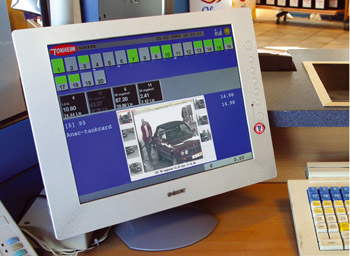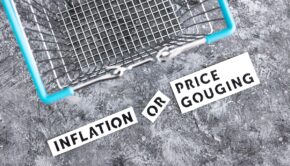Foremost on the forecourt

With fraud costing forecourts thousands of euro annually, security has become a top priority. Thankfully, solutions providers are creating systems that will not only safeguard your business but can also save time and add value.
16 November 2009
Security is an all-important consideration for forecourt retailers. Shoplifting is a keen threat according to Co Wicklow company, ABL Communications and Security, which states a company with a weekly turnover of €10,000 can incur a 2.78% loss through fraud, meaning it can lose out on €14,456 annually. What’s more, drive-offs and over-fills are two offences that frequently occur at many petrol stations.
Fortunately, it has been proven that technological advances can help to cut down the frequency of such crimes. According to Paul Farren of Tokheim, the Tokheim Fuel POS system can be interfaced with CCTV to deliver comprehensive security. He explains that when a customer lifts a nozzle out of the pump, their photograph “is superimposed on the cashier’s screen, so they can check to make sure the right person is paying for the right fuel.” Registration plates are also captured.
Effective integration
Tokheim, which directly services 31,000 forecourts across Europe and whose equipment is used at approximately 80% of petrol stations across Ireland, also claims this system can incorporate many other aspects of forecourt management. Farren notes this includes, “everything from changing the prices on the outside sign to giving the details of the stock on the ground. It also polls the tanks every six seconds to ensure that what’s going out through the pumps, mirrors what’s going out of the tanks on the ground, to deliver full reconciliation for retailers.
“Also, if there is a leak or a leak warning, the system can even create a SMS message to send directly to the manager’s telephone or email.”
Furthermore, he adds that the system can also be linked with car washing machines, telephone top-ups and cigarette vending; “so you remove a lot of peripherals from the counter tops, providing retailers with a lot more space.” Tokheim’s extensive service also means pump engineers are “never more than half an hour” from any forecourt.
Time-saving applications
ABL Communications and Security likewise claims its Fuel Minder automatically activates a camera to focus on the person fuelling a vehicle and then captures a vehicle’s registration, when a nozzle is lifted. In the event of a drive-off, Fuel Minder can also instantly produce a report, incorporating still images for immediate reporting to police.
ABL’s Tillscan application also offers several nifty features which make reviewing security footage a much more time-efficient process for forecourt retailers. One key feature is the ‘smart text search’ facility. This allows retailers to pinpoint a specific transaction by typing in key words. For example, a retailer can choose to show all void sales made in the open deli department by operator Conor Creagh yesterday.
Major investment
Maxol, which currently has 214 service stations in its national retail network, has also engaged in innovative thinking when it comes to delivering greater security at its sites.
Maxol uses Tokheim’s POS system linked to its onsite security system. This captures all active pumps simultaneously, and allows full data to be retained for any subsequent investigations or proceedings. According to Des Duffy, retail manager for Ireland, Maxol, “Attendants have the ability to stop the fuel flow from a particular pump if they feel that it is required.”
The Tokheim Fuel POS system was first introduced in 2002 across Maxol’s network, in order to efficiently handle the euro transition and get onsite retail systems to a PC-based platform, replacing old pump controller type technology.
Duffy says that during 2009, Maxol invested heavily in upgrading both the hardware and software of its Tokheim Fuel POS system, which is linked to the Stationmaster back office solution. It also created a managed Wide Area Network (WAN) linking all company-owned service stations. He believes the forecourt technology employed by Maxol is highly beneficial to the customer in that the integrated POS system allows for instantaneous credit, debit and Maxol Fuelcard processing, hence reducing queuing delays at the payment point. Another important point is that the chance of error has been eliminated as sale amounts do not need to be entered into a separate card terminal.
In fact, in recent years, the company has spent upwards of €2 million in capital expenditure upgrading onsite technology, including over €500,000 in the past six months alone.
Added advantage
Maxol’s solution gives its retailers business-class broadband access. This includes a live connection to eMaxol.com, which is the most advanced customer extranet facility in the industry, giving retailers a whole range of services from Maxol online. Moreover, retailers can benefit from remote access to their service station systems.
Meanwhile, Maxol can receive a live data feed from all company-owned locations to head office. Broadband internet access across the network also allows for key site equipment to be analysed and diagnosed online, facilitating more efficient site maintenance.
Maxol is determined that it will continue to offer forward-thinking technology at its sites moreover. According to Duffy: “Maxol has not allowed the economic downturn lessen its commitment to spending on IT in general and retail technology in particular.”
Greater customer convenience is the company’s focus for the future. “The next step using the technology now in place at Maxol locations is to offer customers pay-at-the-pump services. Essentially, customers are able to pull up at a fuel pump, enter their debit or credit card into a terminal at the pump using the chip-and-pin facility, fill their vehicle and drive away.”
Convenience central
According to Duffy, this system which is currently being introduced at several Maxol service stations in Belfast and is set to be introduced in the Republic soon, “will make the whole fuelling process much more convenient for the customer, because they won’t need to go into the shop itself to pay for their fuel.” The service also “dramatically reduces” the risk of drive-offs and over-fills, as customers cannot pull down any fuel until the system authorises their credit or debit card. Duffy notes therefore that while this makes the operation of fully unmanned stations possible; “the business case for this solution in the Republic is limited by the restriction to issuing diesel only under current regulations.”
While this type of payment offers greater convenience for customers though, does it prevent them from making impulse purchases within the shop? Paul Farren responds that pay-at-pump actually allows customers “to pull away from the pumps, thereby giving them the opportunity to spend more time in the shop, rather than running in and knowing that they’re blocking up the pumps outside on a busy forecourt and they haven’t got the opportunity to browse.” Greater security and convenience therefore appear to be the hallmarks of successful forecourt technology at any site.
Driving forecourt sales on the menu
Retailers have long considered how they can drive greater impulse purchases, when customers who have pulled up for petrol or diesel, walk into their store. Retail Media Systems believes it has come up with an answer which not only attracts customers’ attention, but offers impressive value for money.
Its digital menu displays offer a key advantage in that unlike printed menus, content can be changed easily in seconds. For example, deli menus can quickly be transformed to display the morning or evening offering, or run special offers based on a store’s surplus perishables.
Animated viewing
As Keith O’Reilly, Retail Media Systems, explains, such displays are “colourful, animated and entertaining, and can use text and images from head office or even the internet…Some of our customers display live sports or news updates on their menus for waiting customers to read. Menu displays are changing from a fixed printed list of products and prices to something that informs, entertains and changes with the needs of the customers. Displays are moving into the generation of Twitters, Facebookers and iPoders.”
This flexibility was recognised when the product received the ‘highly commended’ award for Retail Technology Product 2009 at this year’s Shop Expo.
Early adopting
What’s more, Retail Media Systems believes there are several advantages to becoming an early adopter of such technologies. According to O’Reilly: “Within three years digital menu displays will become the norm, so whoever gets them first will get all the attention. Secondly you will start to see savings over printed displays quickly, as it will not cost you anything to change products and prices.
“Thirdly you will see your margins increase by being able to promote your daily specials, and offerings for special events. But most importantly, if you have a display that customers will actually come into your store just to see, you’re going to sell much more.”
Price is right
Is price a prohibitive factor though? “Not at all,” is O’Reilly’s definitive answer. “Both our digital display and in-store music systems are very competitively priced. You can buy a 26” LCD screen for ?270 nowadays so the initial upfront cost is very low. With our digital display systems we estimate that a retailer would recoup their investment in one to two years when compared to printing costs. This is before taking into account that up to 30% of people viewing digital screens make unplanned purchases.”
A broad spectrum of clients ranging from the O2, Donnybrook Fair and Fresh supermarkets to Charlie’s Chinese fast-food restaurants have been impressed with these advantages so far.
Interesting innovation
Such a focus on innovation has long been central to Retail Media Systems, which kick-started in 2005 under the name Donkeymedia. After developing a flexible in-store music player which proved a hit, the company then “discovered an even bigger gap in the market for a flexible digital menu display system.” In 2008, after spending two years researching and developing a solution with customers, it launched its digital signage and menu display platform. Subsequently, Retail Media Systems now supplies businesses in Ireland, UK and Germany. However, it is not content to rest on its laurels and innovation remains a strong element of the business.
O’Reilly explains “some tasty add-ons” are already planned, such as “menu displays that reflect and adjust to the seasons. Further down the road we plan to offer services like using iPhone apps as a loyalty scheme with personalised greetings on the displays and even hooking up with Facebook. All these extras will be available to all our existing customers as well. However our competitive price and great quality will not change.”



 Print
Print






Fans 0
Followers